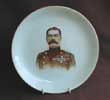
We are not responsible for links to external sites
Maling history1910-1920 - Black ground waresWorld War I proved no impediment to Maling's business, and pieces were produced to mark both the start and end of the war. The pictured plate of Lord Kitchener is believed to have been designed by Mr Miguet, who obviously still had some sort of association with the factory, even at this late date. However, to most collectors, this is the decade when Maling finally achieves its own unique style. Cetem wares of this time are synonymous with 'black ground' pieces. These elegant wares, often featuring oriental or neo-classical designs, are the work of designer Harry Toft, who had joined Maling from the Staffordshire potteries. They are produced by the technique of aerographing (or spray painting). A piece would be decorated while still in the 'biscuit' state. Then the decoration was carefully painted over with a volatile fluid which would burn off in the kiln. Once the pattern had been masked out, the piece would be sprayed all over with the black finish and fired again. The volatile fluid burned off to reveal the design underneath. The Maling name was reintroduced in 1924, and ran in parallel with Cetem until the early 1930s, when the Cetem name was dropped.
|

